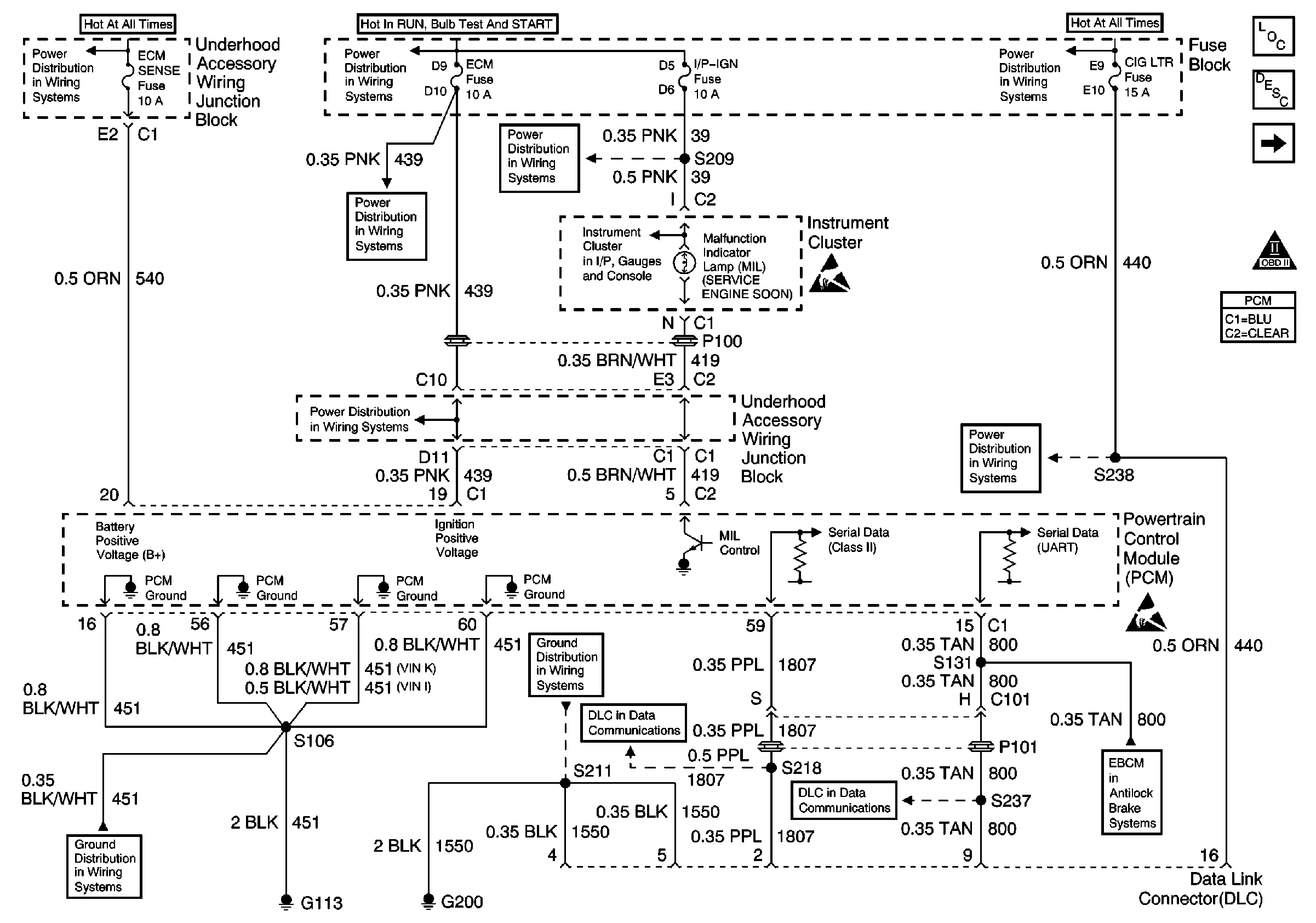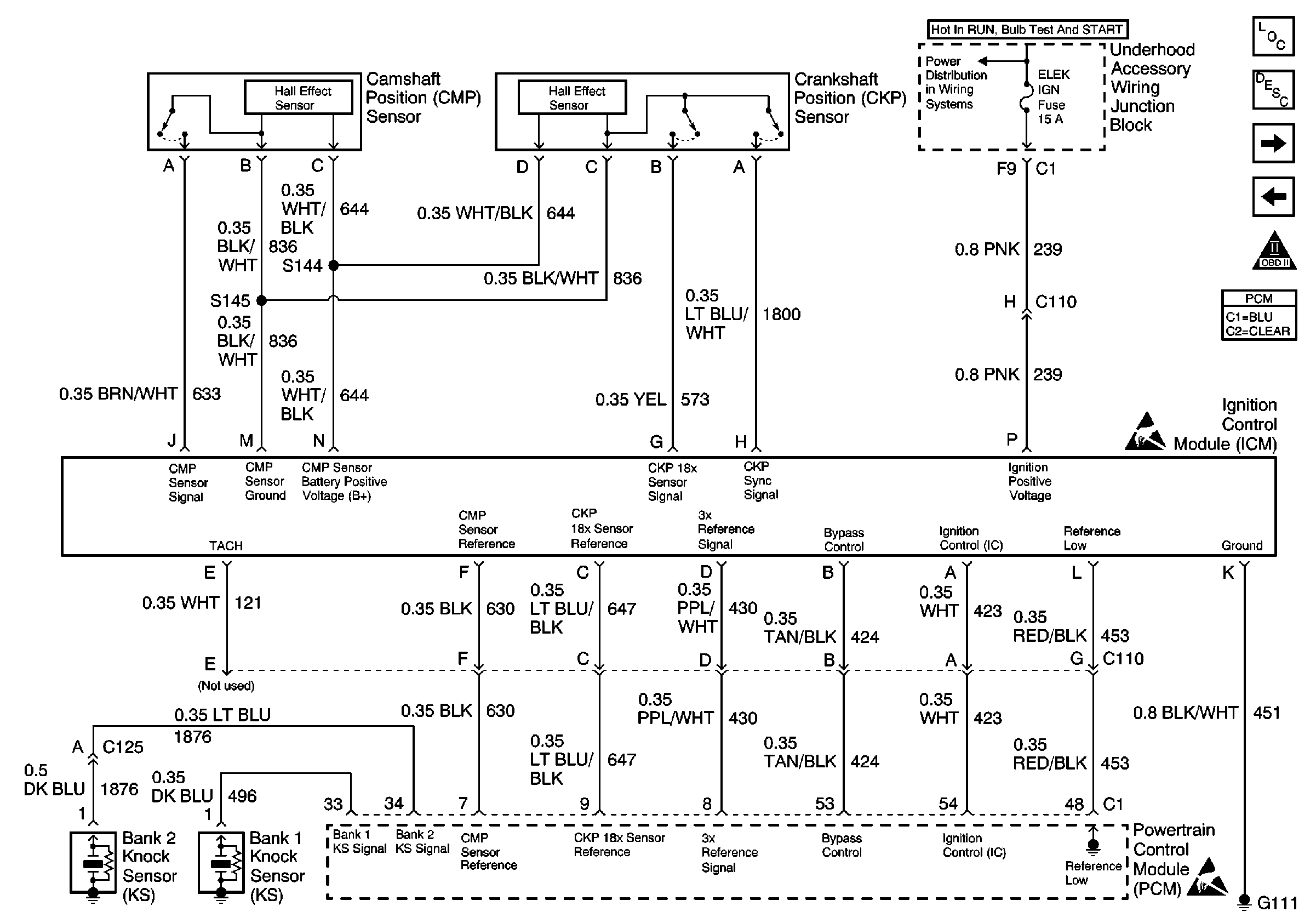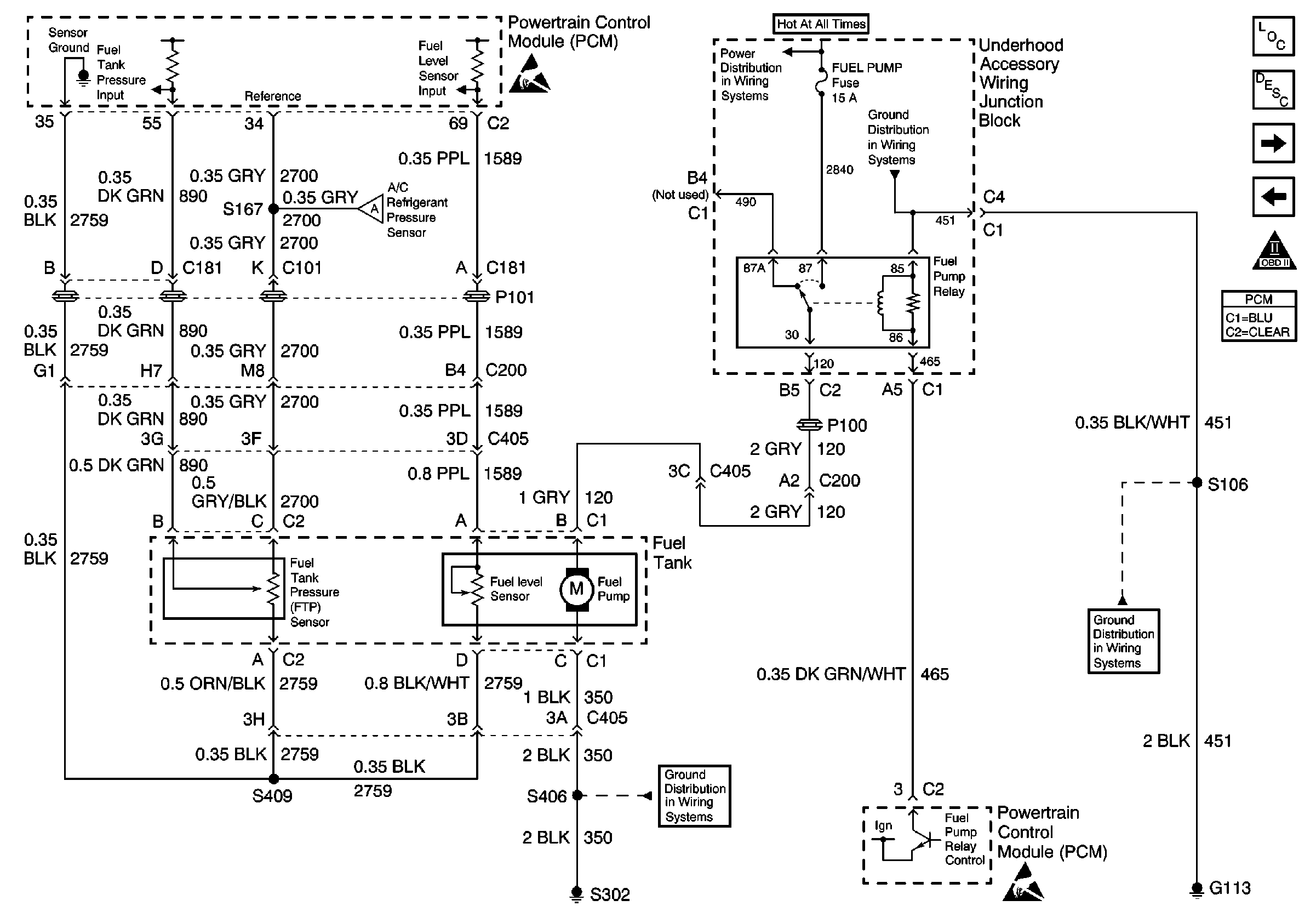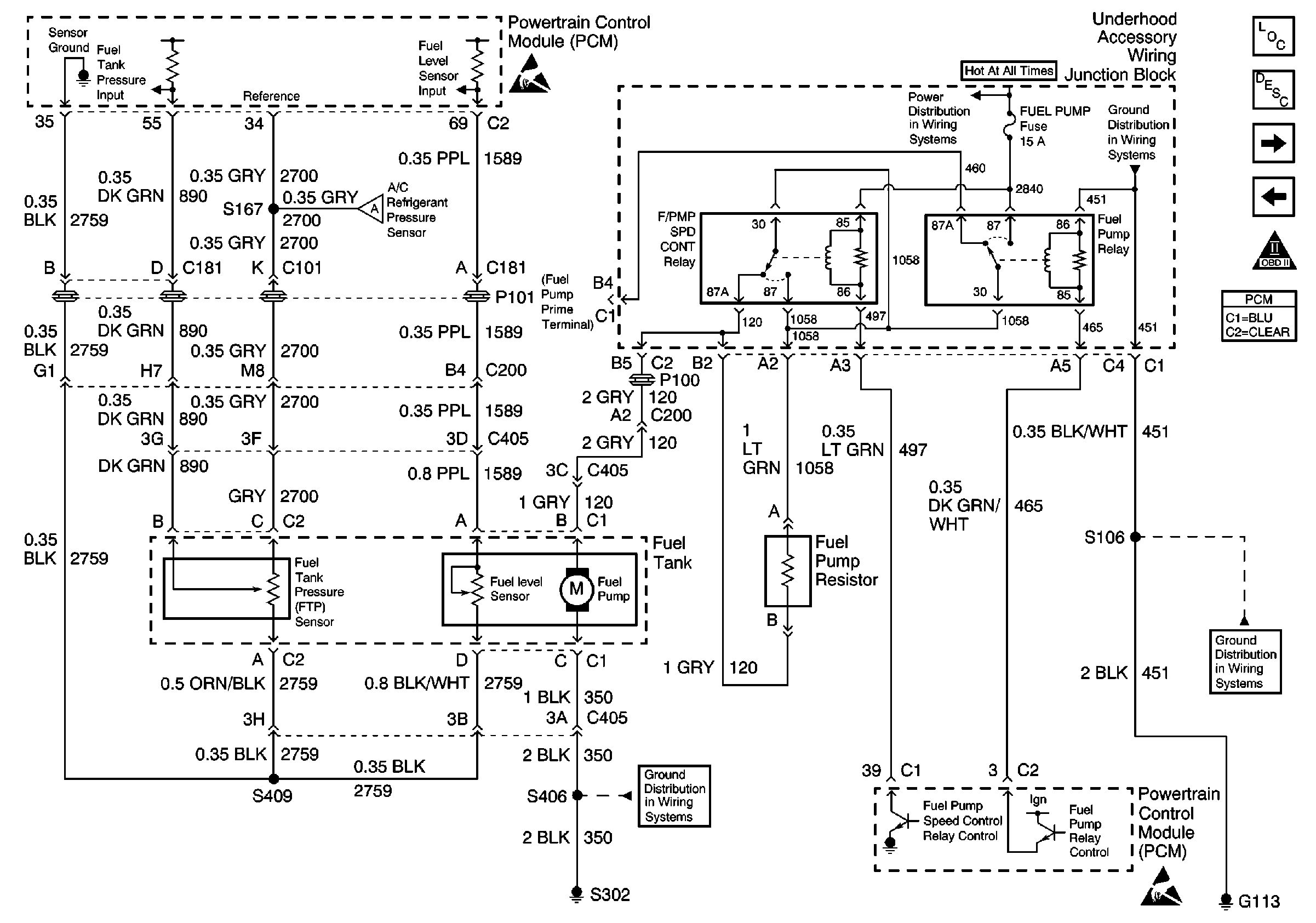Refer to the following Engine Controls Schematics for wiring diagrams:
Circuit Description
The electronic ignition system uses a waste spark method of spark distribution. In this type of ignition system, the ignition control module triggers the correct coil, based on the sync signal that is received from the crankshaft position sensor. This results in both of the spark plugs that are connected to the coil firing at the same time. The spark plug for the cylinder on the exhaust stroke requires less energy in order to fire, leaving the remaining high voltage to fire the spark plug for the cylinder on the compression stroke.
During crank, the ignition control module monitors the CKP sync signal. The CKP sync signal is used in order to determine the correct cylinder pair to fire first. The CKP sync signal is used only by the ignition control module, in order to initiate the ignition coil firing sequence. The signal not passed to the PCM. After the ignition control module processes the CKP sync signal, the ignition control module monitors the 18X CKP signal and sends 18X and 3X reference pulses to the PCM. When the PCM receives these pulses, the PCM will command all 6 injectors, in order to allow a priming shot of fuel for all the cylinders. After the priming, the injectors are left OFF during the next 6 3X reference pulses from the ignition control module. This allows each cylinder a chance to use the fuel from the priming shot. During this waiting period, the PCM receives a camshaft position signal pulse. The camshaft position signal allows the PCM to operate the injectors sequentially, based on the camshaft position. If the camshaft position signal is not present at start-up, the PCM will begin sequential fuel delivery with a 1 in 6 chance that the fuel delivery is correct.
Diagnostic Aids
| • | Inspect all wiring and connections of the PCM harness. |
| • | An intermittent may be caused by the following conditions: |
| - | Poor connections |
| - | Rubbed-through wire insulation |
| - | Broken wire inside the insulation |
| - | Damaged harness |
| - | Improper mating |
| - | Improperly formed or damaged terminals |
| - | Poor terminal-to-wire connection |
| • | A faulty engine coolant temperature sensor. Use a scan tool in order to compare the engine coolant temperature to the intake air temperature on a completely cool engine. The engine coolant temperature should be within 10°C (14°F) of the intake air temperature. If not, replace the ECT sensor. Refer to Engine Coolant Temperature Sensor Replacement . |
Test Description
The numbers below refer to the step numbers on the diagnostic table:
-
This step determines if the ignition control module (ICM) is receiving the 18X CKP reference signal. If the 18X CKP signal to the ICM is not present, there will be no RPM, no spark, and no fuel injector pulses.
-
This step ensures that the ICM has the proper voltage supply and ground.
-
This step verifies that the ICM is supplying the proper sensor feed voltage.
-
Check for the proper operation of the CKP Sync signal, the ICM, and the related spark system components. Without the CKP Sync signal, the ICM is unable to properly sequence the ignition coils.
-
If the 18X and the CKP Sync signals to the ICM, or if the 18X and 3X reference signals to the PCM short together, the vehicle will not start and run. However, there will be spark and fuel injector pulses.
-
When the PCM is replaced, you must program the new PCM.
Step | Action | Value(s) | Yes | No | ||||||||||||||||
|---|---|---|---|---|---|---|---|---|---|---|---|---|---|---|---|---|---|---|---|---|
1 | Did you perform the Powertrain On Board Diagnostic (OBD) System Check? | -- | ||||||||||||||||||
2 |
Important: If the engine cranks and does not run, test the ignition relay feed circuits to and from the ignition relay. Refer to Power Distribution Schematics and Circuit Testing in Wiring Systems. Important: Before proceeding with this diagnostic table, ensure that the vehicle battery is fully charged. Important: If any DTCs are stored as failed since code clear, except DTC P1374, DTC P0336, or DTC P0341, diagnose the DTCs before continuing with this table.
Did you find and correct any conditions? | -- | ||||||||||||||||||
3 | With a scan tool, command the fuel pump ON. Does the fuel pump turn ON? | -- | ||||||||||||||||||
4 |
Caution: Wrap a shop towel around the fuel pressure connection in order to reduce the risk of fire and personal injury. The towel will absorb any fuel leakage that occurs during the connection of the fuel pressure gage. Place the towel in an approved container when the connection of the fuel pressure gage is complete. Does the fuel pressure measure within the specified values and is the pressure holding? | 333-376 kPa (48-55 psi) | Go to Fuel System Pressure Test (VIN K) or Fuel System Pressure Test (VIN 1) | |||||||||||||||||
Caution: Wrap a shop towel around the fuel pressure connection in order to reduce the risk of fire and personal injury. The towel will absorb any fuel leakage that occurs during the connection of the fuel pressure gage. Place the towel in an approved container when the connection of the fuel pressure gage is complete. Does the scan tool indicate engine RPM? | -- | |||||||||||||||||||
Does the test lamp illuminate? | -- | |||||||||||||||||||
7 |
Does the test lamp illuminate? | -- | ||||||||||||||||||
Does the voltage measure near the specified value? | B+ | |||||||||||||||||||
9 | Connect a DMM between the 18X CKP sensor signal circuit and sensor ground circuit at the connector. Does the voltage measure in the specified range? | 6-8V | ||||||||||||||||||
10 | Inspect for faulty terminal connections at the 18X CKP sensor. Repair the condition as necessary. Refer to Wiring Repairs in Wiring Systems. Did you find and correct the condition? | -- | ||||||||||||||||||
11 | Connect a DMM between the 18X CKP sensor feed circuit and the engine ground. Does the voltage measure near the specified value? | B+ | ||||||||||||||||||
12 |
Did you find and correct the condition? | -- |
| |||||||||||||||||
13 |
Did you find and correct the condition? | -- | ||||||||||||||||||
14 |
Does the voltage measure near the specified value? | B+ | ||||||||||||||||||
15 | Locate and repair the short between the 18X CKP sensor signal circuit and the following circuits:
Refer to Wiring Repairs in Wiring Systems. Did you find and correct the condition? | -- | -- | |||||||||||||||||
16 |
Did you find and correct the condition? | -- | ||||||||||||||||||
17 |
Does the injector test lamp illuminate for any of the injectors? | -- | ||||||||||||||||||
18 |
Does the test lamp illuminate for any of the injectors? | -- | ||||||||||||||||||
19 |
Did the injector test lamp blink for each injector? | -- | ||||||||||||||||||
20 | Did the injector test lamp blink for any of the injectors? | -- | ||||||||||||||||||
21 |
Did you find and correct the condition? | -- | ||||||||||||||||||
22 |
Does the test lamp illuminate for each injector? | -- | ||||||||||||||||||
23 | Locate and repair the open ignition positive feed circuit to the fuel injectors. Refer to Wiring Repairs in Wiring Systems. Did you find and correct the condition? | -- | -- | |||||||||||||||||
Is spark available at all cylinders? | -- | |||||||||||||||||||
25 | Is spark available at any cylinder? | -- | ||||||||||||||||||
26 |
Is the voltage in the specified range? | 6-8V | ||||||||||||||||||
27 |
Did you find and correct the condition? | -- | ||||||||||||||||||
28 |
Did you find and correct the condition? | -- | ||||||||||||||||||
29 |
Did you find and correct the condition? | -- | ||||||||||||||||||
30 |
Did you find and correct the condition? | -- | ||||||||||||||||||
31 |
Did you complete the replacement? | 5K-8K ohms (5000 - 8000 ohms) | ||||||||||||||||||
32 |
Did you find and correct the condition? | 600 ohms/ft | ||||||||||||||||||
33 |
Does the test lamp blink continuously while you crank the engine? | -- | ||||||||||||||||||
34 |
| -- | ||||||||||||||||||
Did you find and correct the condition? | -- | |||||||||||||||||||
36 |
Did you find and correct the condition? | -- | ||||||||||||||||||
37 | Repair the engine mechanical problem. Refer to Engine Compression Test in Engine Mechanical in order to diagnose the following conditions:
Did you complete the repairs? | -- | -- | |||||||||||||||||
38 | Inspect for faulty terminal connections at the ICM. If you find a problem, repair the condition as necessary. Refer to Wiring Repairs in Wiring Systems. Did you find and correct the condition? | -- | ||||||||||||||||||
39 | Locate and repair the open in the ICM ground circuit. Refer to Wiring Repairs in Wiring Systems. Did you find and correct the condition? | -- | -- | |||||||||||||||||
40 | Locate and repair the open in the ignition positive feed circuit to the ICM. Refer to Wiring Repairs in Wiring Systems. Did you find and correct the condition? | -- | -- | |||||||||||||||||
41 | Replace the 18X CKP sensor. Refer to Crankshaft Position Sensor Replacement . Did you complete the replacement? | -- | -- | |||||||||||||||||
42 | Replace the ICM. Refer to Ignition Control Module Replacement . Did you complete the replacement? | -- | -- | |||||||||||||||||
43 | Locate and repair the short to ground in the fuel injector control circuits that are associated with the injector test lamps that stayed ON. Refer to Wiring Repairs in Wiring Systems. Did you find and correct the condition? | -- | -- | |||||||||||||||||
44 | Inspect for faulty terminal connections at the PCM. If you find a problem, repair the condition as necessary. Refer to Wiring Repairs in Wiring Systems. Did you find and correct the condition? | -- | ||||||||||||||||||
45 | Replace the ignition coils that are associated with the cylinders that did not have spark. Refer to Ignition Coil Replacement . Did you complete the replacement? | -- | -- | |||||||||||||||||
|
Important: You must program the replacement PCM. Replace the PCM. Refer to Powertrain Control Module Replacement/Programming . Did you complete the replacement? | -- | -- |




